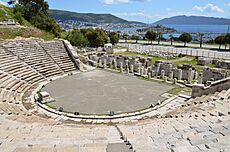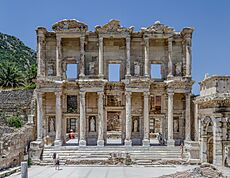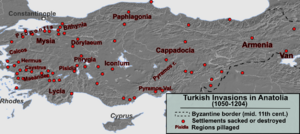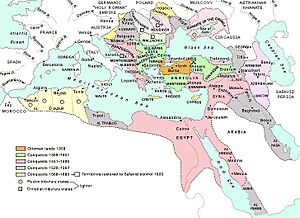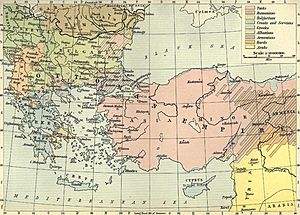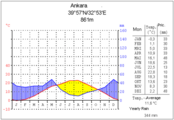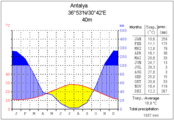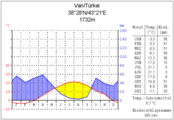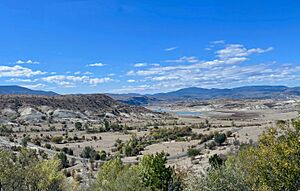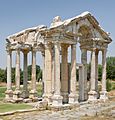Anatolia facts for kids
|
Anadolu
|
|
|---|---|
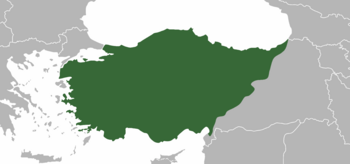
Anatolia, also known as Asia Minor, has two definitions. It is either bounded by an imprecise line from the Gulf of Iskenderun to the Black Sea, or it is the entire Asian area of Turkey.
|
|
| Etymology | "the East", from Greek |
| Geography | |
| Location | Turkey |
| Coordinates | 39°N 35°E / 39°N 35°E |
| Area | 756,000 km2 (292,000 sq mi) (incl. Southeastern and Eastern Anatolia Region) |
| Administration | |
|
Turkey
|
|
| Largest city | Ankara (pop. 5,700,000) |
| Demographics | |
| Demonym | Anatolian (Turkish: Anadolulu) |
| Languages | Turkish Minority: Kurdish, Armenian, Greek, Kabardian, North Caucasian languages, various others |
| Ethnic groups | Turks, Kurds, Armenians, Chechens, Circassians, Greeks, Laz, various others |
| Additional information | |
| Time zone |
|
Anatolia (Turkish: Anadolu), also called Asia Minor, is a large peninsula in Turkey. It makes up most of Turkey's land today. Geographically, Anatolia is surrounded by water on three sides. The Mediterranean Sea is to the south, the Aegean Sea to the west, and the Black Sea to the north. The Turkish Straits are to the northwest. These straits connect the Black Sea to the Aegean Sea. They also separate Anatolia from Thrace in Europe.
Many ancient people lived in Anatolia. They spoke languages like Hittite and Luwian. Over time, Greek became more common. Later, the Seljuk Empire and then the Ottoman Empire brought the Turkish language and Islam to Anatolia. Today, Turkish is the main language. However, some minority languages like Kurdish and Armenian are still spoken.
Contents
- Exploring Anatolia's Geography
- What Does "Anatolia" Mean?
- Different Names for Anatolia
- Anatolia's Long History
- Anatolia's Geology and Landscape
- People of Anatolia
- Images for kids
- See also
Exploring Anatolia's Geography
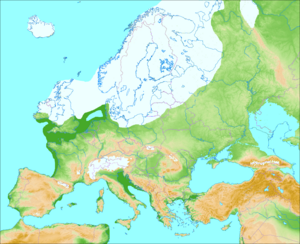
Anatolia stretches east to a line from the Gulf of Alexandretta to the Black Sea. This area includes the Anatolian Plateau. To the east, it is bordered by the Armenian Highlands and the Euphrates river. To the southeast, mountains separate it from Syria and Mesopotamia.
The highest mountain in eastern Anatolia is Mount Ararat, which is 5,123 meters (16,808 feet) tall. Important rivers like the Euphrates and Aras flow through this region.
What Does "Anatolia" Mean?
The name Anatolia comes from the Greek word Anatolḗ. This word means "the East" or "sunrise." It refers to the direction where the sun comes up. Other similar words in different languages, like "levant" and "orient," also mean "east" or "to rise."
Over time, the meaning of Anatolia changed. It first referred to Greek colonies on the eastern Aegean coast. Later, it was used for eastern regions in general. In the Byzantine Empire, after losing other eastern lands, Asia Minor became the main "Eastern" part of the empire. The modern Turkish name, Anadolu, comes directly from the Greek Anatolḗ.
Different Names for Anatolia
The oldest known name for a part of Anatolia was the "Land of Hatti." This name was first used for the ancient Hattians. Later, it became a common name for the land ruled by the Hittites.
The Greeks first called the Anatolian peninsula Asía. This name might have come from an Akkadian word for "sunrise." The Romans used "Asia" for their province in western Anatolia. As "Asia" grew to mean the whole continent, Greeks in later times used Asia Minor (meaning "Lesser Asia") for present-day Anatolia.
When the Seljuk Turks arrived, they called the region Rōmanía, meaning "the land of the Romans." This is why they founded the Sultanate of Rûm. By the 12th century, Europeans started calling Anatolia Turchia.
During the Ottoman Empire, some maps called eastern Anatolia "Armenia" or "Kurdistan." Today, Turkey divides the region into geographical areas like the Eastern Anatolia Region and the Southeastern Anatolia Region.
Anatolia's Long History
Life in Prehistoric Anatolia
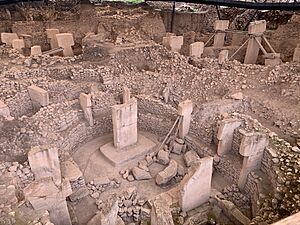
People have lived in Anatolia since the Stone Age. Early farming villages like Çatalhöyük (around 7,000 BCE) were very advanced. Scientists believe that farming spread from the Middle East to Europe because early farmers from Anatolia moved there about 9,000 years ago. These farmers had ancestors who were hunter-gatherers in Anatolia. This suggests that the people living there learned farming themselves. Many modern Europeans have ancestors from these early Anatolian farmers.
Some experts think Anatolia was the original home of the Indo-European languages. These are a large family of languages spoken across Europe and parts of Asia. The earliest known Indo-European languages, like Anatolian languages, were spoken here since at least 1900 BCE.
Ancient Kingdoms of Anatolia
The first historical records of Anatolia come from the Bronze Age. This period includes the rise of the Hattians and the Hittites.
Hattians and Hurrians
The earliest known people in central Anatolia were the Hattians. East of them lived the Hurrians. The Hattians were native to the area, with their main city being Hattush. The Hurrian language is different and is now extinct. Anatolia was known for its raw materials. Trade between Anatolia and Mesopotamia began around 2100 BCE. Assyrian traders exchanged tin and textiles for copper, silver, and gold.
The Powerful Hittite Empire (1800–1200 BCE)
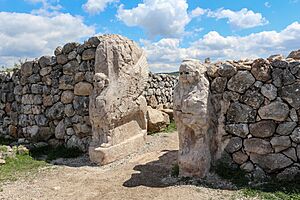
The Hittites were an Indo-European speaking people. They made their capital at Hattusa in north-central Anatolia by the 17th century BCE. They took over from the Hattian and Hurrian people. The Hittites used a writing system called cuneiform, which they learned from Mesopotamia.
The Hittite New Kingdom started around 1650 BCE. It grew into a large empire by the 14th century BCE. It controlled much of Asia Minor and parts of Syria and Mesopotamia. The Hittites often fought with the empires of Egypt, Assyria, and Mitanni. The Assyrians eventually took over many Hittite lands.
Anatolia After the Hittites (1200–600 BCE)
After 1180 BCE, the Hittite Empire broke apart. New groups like the Phrygians moved into Anatolia.
- Luwians: The Luwians were another Indo-European group. Their language was similar to Hittite. From the 9th century BCE, Luwian regions formed states like Lydia and Caria. These states were influenced by Greek culture.
- Assyrian Empire: From the 10th to 7th centuries BCE, much of southeastern Anatolia was part of the Neo-Assyrian Empire. This included many smaller states. The Assyrian empire eventually collapsed.
- Cimmerian and Scythian Invasions: Around the late 8th century BCE, new groups called the Cimmerians and Scythians entered northern Anatolia. They caused trouble for regions like Phrygia and Urartu.
- Early Greek Settlements: Greeks from the Mycenaean culture lived on the northwestern coast of Anatolia from the 20th century BCE. Later, Ionian Greeks settled the west coast. Many Greek city-states were built along the coasts. Western philosophy even began on Anatolia's western coast.
Classical Anatolia's Golden Age
In ancient times, historians like Herodotus described Anatolia as having many different cultures and languages. Regions included Bithynia in the north, Lydia in the west, and Cilicia in the south. Inland regions included Phrygia and Cappadocia.
Anatolia is famous as the birthplace of minted coins. These first appeared in Lydia around the 7th century BCE. Coins helped trade grow during the Greek and Roman times.
Around 500 BCE, the Persian Achaemenid Empire conquered all of Anatolia. The Greek cities on the west coast rebelled in the Ionian Revolt. This led to the Greco-Persian Wars, which the Greeks won. Later, Persia regained control of Ionia.
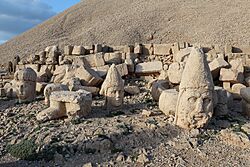
In 334 BCE, Alexander the Great, the Greek king of Macedonia, conquered Anatolia from the Persians. His conquest brought Greek culture and settlements to the inner parts of Asia Minor. After Alexander's death, Anatolia was ruled by different Greek kingdoms, like the Seleucids. Greek culture became very strong, and local Anatolian languages slowly disappeared by the 1st century BCE.
Later, the Roman Republic gained control of western and central Anatolia. However, Greek culture remained important. Mithridates VI Eupator, the ruler of Kingdom of Pontus, fought against Rome to stop its power from growing. Rome eventually took over all of Anatolia, except for the eastern border with the Parthian Empire.
Early Christian Times
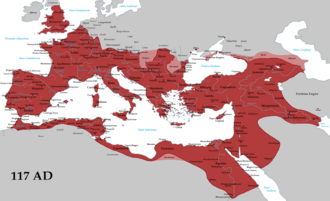
After the Roman Empire split, Anatolia became part of the Eastern Roman Empire. In the 1st century CE, Anatolia was one of the first places where Christianity spread. By the 4th century CE, most of western and central Anatolia was Christian and Greek-speaking.
Byzantine Anatolia was very rich and had many people. Its wealth grew in the 4th and 5th centuries. Large cities like Ephesus and Pergamum were important centers. However, cities began to decline from the mid-5th century. This might have been due to a plague, wars, or Arab invasions.
Medieval Period in Anatolia
After the Battle of Manzikert in 1071, the Seljuk Turks from Central Asia moved into Anatolia. They brought the Turkish language and the Islamic religion. This began Anatolia's change from being mostly Christian and Greek-speaking to mostly Muslim and Turkish-speaking. However, groups like Armenians, Greeks, and Assyrians remained.
In the next century, the Byzantines got back some control in western and northern Anatolia. But eventually, the Seljuk Sultanate of Rûm controlled more and more land.
In 1255, the Mongols swept through eastern and central Anatolia. They stayed until 1335. After the Mongol power weakened, many small Turkish states, called Anatolian beyliks, took control. The Osmanli ruler Osman I was the first Turkish leader to mint his own coins in the 1320s. This showed that the Ottomans were becoming independent from the Mongols.
The Rise of the Ottoman Empire
Among the Turkish leaders, the Ottomans became very powerful under Osman I and his son Orhan. The Ottomans gradually took over the other Anatolian beyliks during the 15th century. They completed their conquest of the peninsula in 1517.
Anatolia in Modern Times
In the 19th century, as the Ottoman Empire declined, many Muslim groups from the Caucasus region moved to Anatolia. These included Circassians and Tatars. Also, as the Ottoman Empire lost land in the Balkans, many non-Christian people, mainly Balkan Muslims, moved to Anatolia.
At the same time, some Greeks from Anatolia moved to the newly independent Kingdom of Greece or other countries. After 1828, many Armenians from eastern Anatolia moved to the Russian Empire.
Anatolia was home to many different ethnic groups until the early 20th century. During World War I, many ancient communities of Armenians, Greeks, and Assyrians in Anatolia experienced significant population changes. After the Greco-Turkish War of 1919–1922, most remaining ethnic Anatolian Greeks moved to Greece in a population exchange in 1923. Today, fewer than 5,000 Greeks live in Anatolia.
Anatolia's Geology and Landscape
Anatolia's land is very complex. It has a central plateau with uplifted blocks and valleys. This plateau is surrounded by two mountain ranges that meet in the east. Flat land is rare. It is mostly found along the narrow coastal strips of the Aegean, Mediterranean, and Black Seas. Some flat plains exist around Lake Tuz (Salt Lake) and the Konya Basin.
The Taurus and Zagros mountains are two important mountain ranges in southern Anatolia.
Anatolia's Climate Zones
- Temperatures of Anatolia
-
Ankara (central Anatolia)
-
Antalya (southern Anatolia)
-
Van (eastern Anatolia)
Anatolia has many different climates:
- The central plateau has a continental climate. This means hot summers and cold, snowy winters.
- The south and west coasts have a Mediterranean climate. They have mild, rainy winters and warm, dry summers.
- The Black Sea and Marmara coasts have a temperate oceanic climate. They have warm, foggy summers and a lot of rain all year.
Nature and Ecoregions

Anatolia has many different types of plants and animals.
- The northern mountains and coast have a humid and mild climate. Here you find temperate broadleaf and coniferous forests.
- The central and eastern plateau is drier. It has deciduous forests and forest steppes.
- Western and southern Anatolia have a Mediterranean climate. They have Mediterranean forests, woodlands, and scrub ecoregions.
Some specific ecoregions include:
- Euxine-Colchic deciduous forests: These forests are along the Black Sea coast in northern Anatolia. They include areas of temperate rainforest.
- Northern Anatolian conifer and deciduous forests: These are in the northern Anatolian mountains.
- Central Anatolian deciduous forests: These cover the central plateau with oak and pine trees.
- Central Anatolian steppe: These are dry grasslands around salt lakes in central Anatolia.

- Eastern Anatolian deciduous forests: These are on the eastern plateau, with oak forests and shrublands.
- Anatolian conifer and deciduous mixed forests: These are in western Anatolia, with pine and oak woodlands.
- Aegean and Western Turkey sclerophyllous and mixed forests: These are along the western coast, with pine forests and maquis shrubland (dense shrubs).
- Southern Anatolian montane conifer and deciduous forests: These are in the Taurus Mountains in southern Anatolia. They have conifer forests like cedar and fir.
- Eastern Mediterranean conifer-sclerophyllous-broadleaf forests: These are along the southern coast, with pine forests and shrublands.
People of Anatolia
The largest cities in Anatolia (not counting the Asian side of Istanbul) are Ankara, İzmir, Bursa, Antalya, Konya, Adana, İzmit, Mersin, Manisa, Kayseri, Samsun, Balıkesir, Kahramanmaraş, Aydın, Adapazarı, Denizli, Muğla, Eskişehir, Trabzon, Ordu, Afyonkarahisar, Sivas, Tokat, Zonguldak, Kütahya, Çanakkale, Osmaniye and Çorum. All of these cities have populations of more than 500,000 people.
Images for kids
-
Fairy chimneys in Cappadocia.
-
The Sebasteion in Aphrodisias of Caria.
-
The Tetrapylon in Aphrodisias of Caria.
See also
 In Spanish: Anatolia para niños
In Spanish: Anatolia para niños
- Aeolis
- Anatolian hypothesis
- Anatolianism
- Anatolian leopard
- Anatolian Plate
- Anatolian Shepherd
- Ancient kingdoms of Anatolia
- Antigonid dynasty
- Doris (Asia Minor)
- Empire of Nicaea
- Empire of Trebizond
- Gordium
- Lycaonia
- Midas
- Miletus
- Myra
- Pentarchy
- Pontic Greeks
- Rumi
- Saint Anatolia
- Saint John
- Saint Nicholas
- Saint Paul
- Seleucid Empire
- Seven churches of Asia
- Seven Sleepers
- Tarsus
- Troad
- Turkic migration


